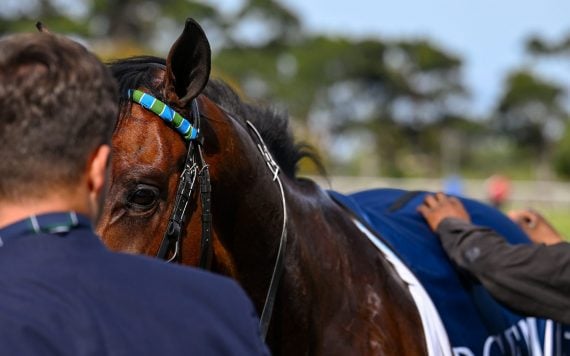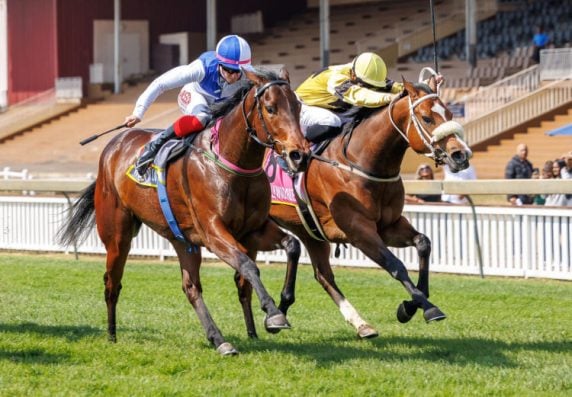Wow, what a tough column this week. I was all excited sitting down to the weekend’s billed racing extravaganza – Classic Day at Turffontein with some seriously good horses and racing on offer, combined with ‘The Olympics of Horse Racing’, the Dubai World Cup from Meydan. I recently read a World Cup write-up by Mandy Haskin. It was beautiful. She swathed the meeting in mystery and beauty and theatre, making it sound like a chapter out of 1001 Arabian Nights. Exotic. Exciting. Romantic.
So how did it all pan out ? Well, there had been some great build-ups and there were some great results from Classic Day. It was a sensational day for the incomparable Dancewiththedevil, Gavin Lerena showed why he’s making the ‘two Ants’ sweat by riding a blinding card, Franny provided another budding superstar from sire sensation Trippi (for another racing super star, the gracious Mrs Oppenheimer), Gavin van Zyl enjoyed a phenomenal run of form for the day, I loved War Horse’s victory (see what I did there?) in the Protea Stakes, MDK had a fabulous 1-2 in the Jacaranda Handicap, the raiders claimed a few scalps and there were a few upsets just to keep things interesting.
Interspersed with the day’s festivities, we had flashes of World Cup Day from Meydan. There was something for everyone – rich races, glamorous lady jockeys, and superb trainers, horses and riders. Really the sort of fare to make even the most hardened Capetonian forsake a day’s sunshine for the attractions of a couch and a flat screen.
But as everyone who watched the 3rd race knows, it seems that even the world’s richest race meeting with its 1km long race course and its glitz and glamour is not immune from racing’s blight. I’m not having a go at Tellytrack – apparently they had no way of turning off the international feed which showed stomach-turning live coverage and then a replay of Fox Hunt ‘falling’ in the Gold Cup. Jockey Silvestre de Sousa emerged shaken, but unhurt.
I’ve never thought much about bridles other than as functional pieces of tack. They usually travel to and from race meetings on a horse and they are just a part of the normal race day paraphernalia. But there is something altogether disquieting watching a jockey carry one off the track. de Sousa sat in the van, looking almost bewildered at the object in his hands.
But if Fox Hunt’s fall was meant to serve as a warning, it fell on deaf ears. The Gold Cup seemed to have some sort of bad ju-ju as the decision to re-run the race later in the evening saw two additional horses ‘fall’. I turned off my TV in disgust and it has been silent ever since while I try to absorb all this and where I fit into the greater scheme of things.
New York Times Article
All this follows hot on the heels of a recent expose run by the New York Times on race day fatalities in horses in the US. People seem to be laying the blame squarely at the door of race day drugs.
There have been rumblings since the outcry surrounding Eight Belles’ infamous breakdown in the Kentucky Derby in 2008. There was a public outcry, Congress got involved, and the US racing industry committed to making racing safer for horses and riders. However, things appear to be getting worse.
7 May 2011 is cited as one of the most dangerous days in the history of American horse-racing with 23 accidents at tracks across the USA, including Archarcharch and Comma To The Top in the 137’th running of the Kentucky Derby.
3 horses had to be destroyed during the filming of recent TV mini series Luck. There was a public outcry and the production was shut down. Interestingly the New York Times investigation states during the same period 613 other horses died at California race tracks. No repercussions on that as far as I’ve been able to tell.
And it’s not just the horses. In early February this year, US jockey Mark Anthony Villa was thrown off his horse as it ‘fell’ just past the post. He tried to crawl to safety. He never made it. A horse’s hoof struck him in the head with such force that his helmet shot like a bullet across the track. He died instantly, leaving a wife and twin children.
At Charles Town on 29 February 2012, 8 horses lined up for the 8th race. 1 finished. The following race had to be cancelled, not because it took so long to clear the track, but because too few jockeys were available or willing to ride.
As Dr Tom David, a former equine medical director for Louisiana Racing Commission says – It just doesn’t smell right.
What’s that got to do with me ?
So what, I hear you think. Race day drugs are permitted in the US. In fact, there are even some parties who question why rules that are good enough for the Yanks aren’t good enough for us? And there’s the rub. You see, we get used to things. I believe the scientific behavioural term is ‘conditioned’. Inured. Indifferent. It’s been an accepted norm ‘over there’ for so long now, that people think, well, it’s really not so bad, is it ? And as we’ve seen, people start to question why we can’t have it here.
And what shocks me is the fact that more and more I’m finding people trying to convince me that meds are OK. ‘Steroids have an unfortunate reputation – they’re not really that bad’. ‘It’s a fast-acting drug’. ‘Everyone else does it. I need it to be competitive’.
Oh, I’m sorry ! I had no idea! Poor you. I see now, you had no choice. Where did I put that violin…
And it’s not just meds. It’s our approach to the industry on the whole. Because there is a weird dichotomy isn’t there? On the one hand, we pretend to be a business. On the other, we pretend to be a sport. And there are arguments for and against both. There are no rules requiring lofty ideals in order to be part of the game.
But isn’t there some sort of social imperative to maintain a certain minimum standard? In this ridiculously politically correct world it becomes all too easy to hide behind potential legal action, libel, etc. We don’t want to get involved. It’s none of our business. So we just turn a blind eye out there safe on the side lines. And hey, good for you if that allows you to sleep at night. You pays your money, you takes your chance the same as the next guy. How you choose to conduct your business is, well, your business.
What about the NHRA ?
With all this who-ha I thought I’d ring up the NHA and ask about banned substances. Because you see, the line between acceptable and banned is not terribly clear. Some medications are perfectly acceptable if used in a therapeutic capacity (ie at any time other than on a race day). Some of them, you’ll be interested to hear, the NHA even issue usage guidelines as to their use in order to make sure that all the checks and balances even out when those specimen collectors come around on race day. So are these substances illegal or not ? Well, it sort of depends on your timing and it sort of depends on your definition of therapeutic use.
So it comes down to semantics, doesn’t it ? Pity horses can’t talk and join the debate. What does ‘performance enhancing’ mean ? One person would say Anabolic Steroids, another any substances that make a horse perform better than it would ordinarily be able to. I don’t do my best work with a migraine – would Myprodol therefore count as performance enhancing ? It may not be a steroid, but it certainly allows me to function better during my work day than I would have otherwise.
Are we not simply trying to please everyone and robbing Peter to pay Paul ? We fence sit, hum and haw and no-one seems prepared to take a strong line on anything. Or we do, but with caveats. Wouldn’t want to upset anyone. And people need to make a living, so one has to make allowances here and there. What harm can a little bit do ? We’re following the guidelines. We’re using meds ‘safely’.
Bollocks. Every single day you have a choice. Behavioural trainers will tell you that everything you do, every minute you spend with a horse, you are training it. Whether you mean to or not. And I’m saying that every thing that you as an owner, a trainer, a jockey, a groom, a veterinarian, etc do (or do not do) with a horse sets an example. And tells the rest of the world a little bit about you. Whether you mean it to or not. Think about that sometime.
Once we start down that slippery slope, we open a whole dark, ugly Pandora’s box of horror and depravity. ‘It’s only a small dose’. But what exactly is a ‘safe amount’? We all have different genetic make-up and different tolerance levels. But the usual ‘do not operate heavy machinery’ cannot be applied to horses. Can we slap a notice ‘Do not break down on the training or race track ?’ on the instructions ? Threshold amount. Ha.
Once you open the door, there is no more black and white. Just a sea of varying shades of grey. And those who navigate those nuances cleverly enough, well, to him the spoils.
So our horses may end up in the winner’s enclosure with a little help. So they may end up in the breeding barn with a little help. And then their progeny may need a little more help to keep them going…. It’s not a great long-term prognosis, is it ?
Why not ?
The reason (I like to think, anyway) that is important for us not to get onto the medical bandwagon, is that we try to market ourselves as a sport. Not a gambling merry-go-round, win-at-all-odds and check your conscience in that the door. If that were the case, then sure, drug the horses up to their eyeballs and race them until they break into a thousand bloody pieces in glorious technicolour all over our screens.
But we say we’re not about that. We say racing is well-policed. That is it clean. That we have an exemplary break-down record. Hmmm. I agree that our records might reflect good results on tests performed. I agree that our officials in charge of policing racing say that their tests do not show up any banned substances in horses on race days. That our incidence of fatalities at race courses is low. It is even possible that some of those statements are true.
I weigh all the evidence and all I can see are direct links between medication, weaker horses and TV and internet horrors. So I don’t have a lot of sympathy with all these whiney-assed cry-babies who want Lasix to be legalised, so that we can allow fundamentally flawed individuals to be able to compete on even terms with their more correct, healthy counter-parts. And perhaps I’m mean and selfish by not wanting to ‘help’ certain horses, but why should we be rewarding what are essentially medicated cripples? Our views and priorities become seriously skewed when it’s only the results that count. Because once that number has been posted in the frame, the how and why is easily forgotten.
Arthur B. Hancock III said “Therapeutic drugs, by definition, are used for healing and curing. Drugs that mask pain and enhance performance are not ‘therapeutic.’ They are what they are: performance enhancing drugs.”
This should be a leisure pursuit in search of ways to improve, strengthen and speed up the breed. Not a blood sport. Performance enhancing. Whatever happened to enhancing the breed? The competition should be on the race track, not the pharmaceutical lab.








